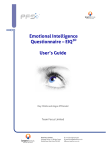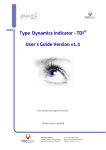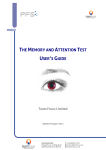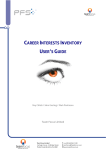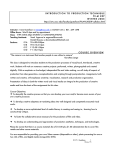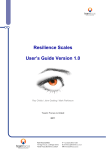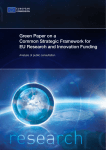Download Emotional Intelligence Questionnaire – EIQ User's
Transcript
Emotional Intelligence Questionnaire – EIQ3D User’s Guide Roy Childs and Angus McDonald Team Focus Limited © 2008-2015 Profiling for Success www.profilingforsuccess.com No part of this material may be reproduced, stored or transmitted in any form or by means, electronic, mechanical, photocopying, recording or otherwise without prior written permission of the publishers. This material may not be photocopied even within the terms of the Copyright Licensing Agency Ltd. The Profiling for Success series is published by Team Focus Limited, Heritage House, 13 Bridge Street, Maidenhead, Berkshire, SL6 8LR, England, tel: +44 (0)1628 637338. V20150128 © 2007 – 2015 Profiling for Success 2 Emotional Intelligence Questionnaire - EIQ3D User’s Guide v3.1 Roy Childs and Angus S McDonald Contents Page Introduction ............................................................................................................... 5 Section One: The concept of emotional intelligence ............................................. 7 What is emotional intelligence? ............................................................................... 7 The case for emotional intelligence ......................................................................... 9 Issues in the measurement of emotional intelligence ............................................ 12 Reflections on emotional intelligence..................................................................... 13 Key benefits of the EIQ3D ..................................................................................... 14 Applications of the EIQ3D ...................................................................................... 15 Section Two: The development of the EIQ3D ....................................................... 19 The EIQ3D model .................................................................................................. 19 Developing the EIQ3D questionnaire..................................................................... 25 Section Three: Administering the EIQ3D .............................................................. 27 The two versions of the EIQ3D .............................................................................. 29 Administration options and the administration process .......................................... 32 Administration when using a ‘co-respondent’ ........................................................ 34 Requirements of the PfS online assessment system ............................................. 36 Section Four: Interpretation and review ................................................................ 37 Descriptions of the EIQ3D underlying scales ......................................................... 37 EIQ3D scores ........................................................................................................ 47 Understanding EIQ3D reports ............................................................................... 51 Conducting a review session ................................................................................. 57 Section Five: Technical information ...................................................................... 63 Composition of the analysis sample ...................................................................... 63 Descriptive statistics .............................................................................................. 64 The concept of reliability ........................................................................................ 66 Reliability statistics................................................................................................. 68 Validity ................................................................................................................... 71 The influence of background factors on scale scores ............................................ 78 References ............................................................................................................... 87 V20150128 © 2007 – 2015 Profiling for Success 3 V20150128 © 2007 – 2015 Profiling for Success 4 Introduction Our emotional lives have been a prominent area of study for psychologists since the late 1800s, though they have been central to the work of writers, artists and, indeed, all human beings for thousands of years. The concept of emotional intelligence brings together a substantial body of thinking in a powerful model for personal growth. Though its roots can be traced back over 70 years, using emotional intelligence effectively is currently recognised by many organisations as being a key element in developing competitive advantage. The Profiling for Success Emotional Intelligence Questionnaire (EIQ3D) is an innovative assessment of emotional intelligence available through the Profiling for Success online assessment system. Developed from applied research and practical experience, it offers a unique window into how we manage our emotional life that can be used for a wide range of organisational applications and beyond. The selfreport EIQ3D includes an option to ask a co-respondent to give their perspective on the respondent, so providing a powerful challenge to a respondent’s selfperceptions. The purpose of this User’s Guide is to support users of the EIQ3D by introducing the background and development of the EIQ3D and offering advice on its applications, administration and working with the results. It does not set out to prescribe a process, but give guidelines that users can tailor to their own preferences and situations as their experience of using the EIQ3D grows. The first section of the User’s Guide for the EIQ3D gives an overview of the research on emotional intelligence, focussing on its definition, issues for assessment and key research findings relevant to the application of emotional intelligence to individuals and organisations. The key features of the EIQ3D are also described here, along with illustrations of how the assessment may be used. V20150128 © 2007 – 2015 Profiling for Success 5 The development of the EIQ3D, from its early roots in leadership competencies through an integrative model of emotional intelligence to its current form as a 360° feedback tool and the questionnaire version presented here, is described in Section Two. The third section covers administration of the EIQ3D, with the fourth dealing with interpretation of the reports and conducting reviews with questionnaire respondents. The fifth section describes the characteristics of the standardisation sample on which the normative data is based, and the technical properties of the EIQ3D including reliability, validity and the influence of background factors on scale scores. It is recommended that all users read Sections Two, Three and Four prior to working with the EIQ3D. Interested readers may also want to read Section One on the background to emotional intelligence and the technical aspects of the EIQ3D in Section Five. V20150128 © 2007 – 2015 Profiling for Success 6 Section One: The concept of emotional intelligence Emotional life has been a central theme of psychology since its inception as a scientific discipline in the 1800s. Emotional intelligence provides a unifying framework for the study and application of emotions which has captured the imagination of academics, practitioners and the public alike. The Profiling for Success Emotional Intelligence Questionnaire (EIQ3D) is an innovative online assessment of emotional intelligence, rigorously developed and based on a comprehensive model of emotional intelligence. The User’s Guide has been developed to support users at all stages of their work with the EIQ3D. This section of the User’s Guide starts with an overview of emotional intelligence, giving a background to its nature, why it is important to individual and organisational life and issues in its assessment. It then goes on to present the thinking behind the EIQ3D before introducing the specific benefits of using the EIQ3D to assess emotional intelligence and areas for application. What is emotional intelligence? Emotional intelligence is somewhat unusual in psychology, as the majority of writers and researchers are in agreement as to its definition, at least at the broadest level. Daniel Goleman (1996, 1998) has probably influenced the definition of emotional intelligence more than any other writer, due to the popularity of his books on the subject, though he draws heavily on the landmark work of Salovey and Mayer who previously defined emotional intelligence as: “the ability to monitor one’s own and other’s emotions, to discriminate among them, and to use the information to guide one’s thinking and actions” (1990, p189). V20150128 © 2007 – 2015 Profiling for Success 7 Three distinct aspects of emotional intelligence follow from Salovey and Mayer’s definition: the ability to accurately appraise emotions in the self and others, through both verbal and non-verbal channels; the ability to regulate or control emotion in the self and others; the ability to use emotion to regulate and direct thought. Salovey and Mayer’s definition reflects work dating from the 1920s by the psychologist Edward Thorndike who proposed an aspect of intelligence that is “the ability to understand and manage men and women, boys and girls – to act widely in human relations” (1920, p288). Edward’s son, Robert Thorndike, furthered research into social intelligence, but in 1937 concluded that attempts to measure social intelligence had been unsuccessful, possibly due to it resulting from the interaction of different abilities (Thorndike and Stein, 1937). Though the idea of social intelligence had fallen out of favour by the 1960s, by the end of the 1970s a new generation of intelligence theorists were seeking to challenge the somewhat limited scope of intelligence. Notable amongst these were Robert Sternberg and Howard Gardner. Sternberg’s (1985) triarchic model of intelligence proposes three types of intelligence – analytical, creative and practical. Although none of Sternberg’s three intelligences have a direct link to emotional intelligence, elements of dealing with the environment and others can be seen in his definitions of creative and practical intelligence. Howard Gardner has challenged what it means to be intelligent more than any psychologist in recent years. In Frames of Mind (1983) he argued for the existence of seven distinct types of intelligence, including interpersonal and intrapersonal. Intrapersonal intelligence concerns the ability to access one’s own feelings, the capacity to discriminate amongst them and draw on them as a means of guiding behaviour, whereas interpersonal intelligence is the ability to understand other people and know what they are feeling. V20150128 © 2007 – 2015 Profiling for Success 8 Certain themes can be drawn from the definitions reviewed here. Emotional intelligence involves both the individual and others; it is the ability to understand your own emotions and those of people around you. Emotions also need to be managed effectively, not by shutting them off but by appreciating their origins and potential effects. A further theme involves how different emotional states can enhance activities such as problem-solving, influencing others and leadership by being motivational, adding depth and authenticity to interactions. Goleman (1998, p27-8) brings many of these ideas together in his five emotional competencies: self awareness – knowing one’s internal states, resources and intuitions; self regulation – managing one’s internal states, impulses and resources; motivation – emotional tendencies that guide or facilitate reaching goals; empathy – awareness of others’ feelings, needs and concerns; social skills – adeptness at inducing desirable responses in others. The case for emotional intelligence Proponents of emotional intelligence have been keen to cite the limited ability of traditional intelligence or ability measures to predict life success (e.g. Goleman, 1998) and have seen this search for predictive power as an important driver behind the interest in emotional intelligence. Such claims do much to misrepresent the proven utility of ability measures (e.g. Schmidt and Hunter, 1998) and also oversimplify the interpretation of the correlation coefficient, the fundamental measure of predictive validity. Emotional intelligence remains, however, a significant capability and is realistically framed in Mayer and Caruso’s words: “EI is an important capability, but one that coexists with many other important strengths and weaknesses, and that it affects some areas more than others” (2002, p4-5). V20150128 © 2007 – 2015 Profiling for Success 9 A number of areas where higher levels of emotional intelligence may prove beneficial are given by Salovey and Mayer (1989-90). Regulating emotions can have a positive effect on planning, particularly in perception of the likelihood of desirable and less desirable outcomes. People in positive moods are known to see positive outcomes as being more likely and negative ones less likely, with the opposite being true for people experiencing negative emotions. The manipulation of emotions can therefore contribute to more realistic appraisals and planning. Creativity and problem-solving are further areas that can utilise emotional intelligence. Positive emotions are associated with more creative responses to standard creativity tasks and greater efficiency in categorisation tasks. The phenomenon of ‘state dependent recall’ also means that people are more likely to recall experiences from their past that match their current emotional state (e.g. Blaney, 1986). Salovey and Mayer (1989-90) also identify the importance of emotions in maintaining motivation and drive in the face of challenging tasks. Individuals are likely to adopt different strategies in how they use emotions for motivational purposes. For example, some may be motivated by the positive emotions that come with success and reward, others may seek the positive emotions that result from creating successful teams and the resulting interactions. For others the emphasis may be more on the avoidance of negative emotions that come with failure, or the use of emotions such as anxiety generated by deadlines to energise and sustain action. Regardless of the approach taken by an individual, emotional intelligence can contribute to motivation through the appreciation, regulation and direction of emotions to achieve desired goals both in the self and others. V20150128 © 2007 – 2015 Profiling for Success 10 The importance of emotional intelligence for general well-being is a further area that has widespread implications for work and personal life. According to a recent CIPD survey, stress is the major cause of long-term absence in non-manual workers (CIPD, 2006). Through the mechanisms of appreciation and regulation of emotional states, higher levels of emotional intelligence will contribute to effective coping with stress and resilience, therefore reducing the levels of stress that are experienced. The examples given above relate to specific activities. Whilst these activities apply to many areas of life, they have been studied extensively in relation to organisational activities such as leadership and teamwork. As many emotions grow out of social interaction (Kemper, 1978), organisational life, and teams in particular, are both a powerful source of emotion and, in turn, are affected by the emotions of their members (Barsade & Gibson, 1998). Goleman (2001) reviews research showing that emotionally intelligent working environments nurture and engage employees and that this, in turn, is reflected in organisational success. The role of leaders in influencing the climate of emotional intelligence can be seen from studies looking at the performance of different divisions within an organisation. Divisions with leaders demonstrating higher levels of emotional competencies exceeded targets by between 15 and 20 percent, compared to those with lower levels of emotional competencies who underperformed by a similar degree (McClelland, 1998). Emotional intelligence has a wide range of applications and is supported by numerous studies to support its practical applications, though only a small sample is given here. Claims for its validity have been exaggerated in the past, but a more mature approach to its application and study has now started to produce a coherent and defensible body of research supporting the validity of emotional intelligence. V20150128 © 2007 – 2015 Profiling for Success 11 Issues in the measurement of emotional intelligence The phrase ‘emotional intelligence’ has posed a particular problem for psychologists as it brings together two elements with very different measurement philosophies. ‘Emotion’ is used to describe strong but short-lived feelings, of which we are usually acutely aware. It is distinguished from terms such as ‘mood’ which reflect longerterm, pervasive but low-level feelings, though the two are clearly not fully independent of each other as reports of emotion over short and much longer timeframes are highly correlated (Watson, Clark and Tellegen, 1988). Whilst some progress has been made in the objective assessment of emotion through techniques such as galvanic skin response (GSR) and more sophisticated brain imaging technologies, self-report checklists or questionnaires remain by far the most prevalent approach. Convenience and relative ease of development are significant reasons for self-report methodology, but more fundamental is the pervasive belief that the individual is always the most valid source of information about their emotional state. The selfreport approach is not without its critics (e.g. McDonald, 2000) as it is not commonly used to assess other aspects of ability and, when it is, associations between selfreport and objective measures are usually weak (e.g. Paulhus, Lysy and Yik, 1998). In contrast to the subjective self-report approaches prevalent in the study of emotions, objective measurement has been the technique most widely applied to the measurement of intelligence. Objective assessments of intelligence or specific abilities (e.g. verbal or numerical reasoning) are widely used in recruitment, development and guidance. These measures most commonly assess analytical ability or crystallised knowledge and are characterised by multiple-choice tests with one correct answer option and a number of incorrect options or ‘distractors’. V20150128 © 2007 – 2015 Profiling for Success 12 The bringing together of the terms ‘emotion’ and ‘intelligence’ has not resulted in a consensus on the most appropriate measurement approach. The majority of emotional intelligence assessments are based on self-report methodology (e.g. Cooper and Sawaf, 1997; Goleman, 1995; and Bar-On, 1998), with the chief advocates of the objective assessment approach being Salovey, Mayer and colleagues (e.g. Mayer, Caruso and Salovey, 1997). So what can be made of these apparently contradictory approaches to evaluating emotional intelligence? To reach a synthesis, it is necessary to appreciate that many measures, whether self-report or objective, contribute to personal or work success but are not direct measures of it. McClelland (1973) and subsequently Boyatzis (1982) emphasised the importance of competence rather than intelligence, viewing competencies as resulting from combinations of knowledge, skills and attributes. Goleman (1988) takes a similar perspective and views emotional intelligence as the basis for acquiring emotional competencies. Empirical evidence for this proposition has been found by Lopes, Salovey and Straus (2003), who showed objective measures of emotional intelligence and self-reports of personality independently contributed to satisfaction with social relationships. There is, therefore, space for objective and self-report assessments of emotional intelligence to co-exist and for both to contribute to understanding emotionally intelligent behaviour. Reflections on emotional intelligence In developing the EIQ3D, one of the major aims was to find a balance between the focus on the individual and the focus on others. Self-report assessments focus primarily on the individual, whereas objective assessments show a bias towards others, meaning many emotional intelligence assessments and models are unbalanced in their emphasis. V20150128 © 2007 – 2015 Profiling for Success 13 A greater focus on the individual can mean that the interpersonal elements of emotional intelligence are given less prominence. It also ignores the fact that whilst emotions are experienced subjectively as an internal state, it is the external world and particularly our relational interactions that are the major source of these emotions (Kemper, 1978). Experience of individual, team and organisational development shows that it is often the interpersonal competencies, particularly those that affect the quality of relationships, which have the biggest impact on success. It is therefore important to appreciate how the intrapersonal elements of emotional intelligence are reflected in the interpersonal world to build positive, healthy relationships. It is our belief that this relational element to emotional intelligence cannot be ignored if interventions in this arena are to be successful. The importance of relationships to all areas of life have been eloquently stated by Schluter and Lee (1993) who also present a model for relational interventions, based on the idea of ‘relational proximity’. A joint appreciation of the self and the relational world, through models such as relational proximity, are the building blocks of a ‘relational intelligence’ to which emotional intelligence is only one contributing factor, albeit a significant one. With this in mind, the EIQ3D focuses equally on both the self and others in its assessment of emotional intelligence, mirroring internal competencies with their equivalent in the external world. It therefore provides a focus for both personal development and the development of competences to build successful relationships. Key benefits of the EIQ3D The EIQ3D has been developed to address key issues in the growth of individuals, teams and organisations. Based on over 10 years of research, empirical analysis and practical experience the EIQ3D combines innovative thinking in the area of emotional intelligence supported by a rigorous analysis of the actual behaviours that contribute to success in the workplace. V20150128 © 2007 – 2015 Profiling for Success 14 Its key benefits include: giving an equal focus to emotional competencies directed internally towards the self and externally towards others, the EIQ3D develops both personal and interpersonal awareness. In directly addressing the relational aspects of emotional intelligence the EIQ3D can be used to support the development of productive relationships, an area increasingly recognised as key to organisational success; the option to include a co-respondent, where another person completes the EIQ3D with references to the respondent, adds a significant dimension to the assessment process by allowing the respondent to better understand how others perceive their emotional competencies; based on a comprehensive model of emotional intelligence, the EIQ3D can be interpreted at the level of nine major areas or 36 underlying scales using both raw score and normative profiles. The EIQ3D model facilitates feedback and development, and provides a common language for individuals, teams and organisations to explore emotional competence; delivered by the Profiling for Success online assessment system, users have full control over the administration and reporting features of EIQ3D. the Questionnaires are automatically analysed to produce expert narrative reports or data-rich administrators’ reports, delivered via email within minutes of completion. Applications of the EIQ3D An understanding of emotional intelligence can play a significant role in many areas. Some of the areas in which it is most commonly applied are introduced below, though this should not be seen as an exhaustive list and users of the EIQ3D are encouraged to adapt and build on these examples. V20150128 © 2007 – 2015 Profiling for Success 15 Personal and career development – The EIQ3D is best viewed as part of a process that allows a respondent to reflect on their reactions to a set of personal competencies to support their development. The individual competencies and the model on which the EIQ3D is based provide a method of structuring a review of results and development activities and, importantly, give a common language for the respondent and a facilitator to work with. The option of using a co-respondent to give their perceptions of the respondent adds a new dimension to the assessment process that is particularly powerful in a development context. The co-respondent provides feedback on how the respondent may come across to others and so challenges some of the biases that can appear through self-report instruments. An analysis of any ‘gaps’ or differences between the two sets of responses provides a particularly powerful area for exploration and development. Development will be most effective when questionnaire results are integrated with the respondent’s personal experiences. Respondents may be encouraged to recall specific experiences, analyse the ‘emotional’ elements of these experiences and relate them to development needs suggested by the EIQ3D. Development activities can then be set and the respondent encouraged to practise and apply their skills in their personal and work life. Team development – Organisations increasingly rely on team performance for their overall success, though these teams may be loosely structured, exist only for the duration of a specific project and may not be co-located (‘virtual’ teams). Diversity in teams is widely recognised as being a strength, but with diversity come differences that can be the source of conflict and impair the co-operation and collaboration. Positive interpersonal interactions and the relationships that develop from these underpin team and organisational success, and are also a significant source of emotion. Without a constructive appreciation of diversity and the strengths of different team members, however, emotions can become ‘hothoused’ in teams and the most significant derailer to success. V20150128 © 2007 – 2015 Profiling for Success 16 The EIQ3D is particularly suited to team development due to its balance between exploring self-focussed and other focussed aspects of emotional intelligence. Starting with individual team members, the EIQ3D supports the individual team members in understanding and developing their personal emotional competencies. Using the co-respondent version of the EIQ3D can be particularly powerful in these circumstances to gain feedback from another member of the team. Teams can then be encouraged to explore how they work together to deal with emotions effectively to build trust, shared identity and group efficacy. The EIQ3D model may be a useful framework for structuring interventions, particularly as it can give teams a shared language for discussing diversity and using this constructively. Recruitment – It is important to recognise that using any self-report questionnaire in recruitment should never be for the purpose of assessing competence. Instead, a self-report questionnaire provides an opportunity for ‘telling their story’ in terms of a structured model. Therefore it is necessary for the competencies in the EIQ3D model are relevant in terms of having an impact on performance – which is likely in jobs where there is a significant emphasis on building good working relationships. However, the questionnaire results should be treated as a way to understand what a person believes (or wants the ‘decision-maker’ to believe). Taken from this point of view, the value of the questionnaire in the selection context is in the discussion and validation of the results which involves further probing and the seeking of supporting evidence1. 1 This is both the most honest and the most appropriate way to use self-report questionnaires although general usage does not always follow this practice V20150128 © 2007 – 2015 Profiling for Success 17 We hope you have enjoyed exploring this free introductory version of the EIQ3D (Emotional Intelligence Questionnaire 3D) User’s Guide. We would be delighted to get your feedback and to discuss your thoughts and reactions. In addition, we hope that you have got a flavour of what the EIQ3D is all about. We realise that not all the features that make this approach innovative and practical have been explained, but you will get some idea by referring to the Table of Contents and the full version will give you more detail about: 1. how the EIQ3D was developed 2. the practicalities of administering in order to engage the person in the process – and in particular the ‘paired process’ whereby a selected ‘other’ also provides feedback 3. ideas about conducting a review (feedback) session 4. the technical psychometric details related to construction, reliability and validity 5. details of the normative samples If you are interested in the complete version, (normally provided to our affiliated partners and clients as part of our training courses) or in discussing your interest further, we welcome you to get in touch by filling in the Contact Form V20130514 © 2008 - 2013 Profiling for Success


















